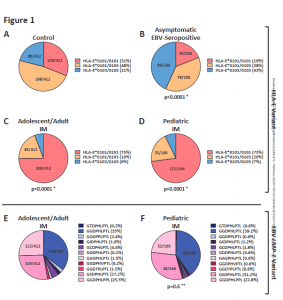Why the Epstein-Barr virus causes infectious mononucleosis (IM) in some persons with first infections but not in others is a mystery to medical research. As the root of the problem and a potential target for vaccine development, a group of researchers have discovered a particular immunological response to the virus (Figure 1).

Figure 1: HLA-E and EBV LMP-1 variants in patients with IM and asymptomatic EBV-546
seropositives: (A-D) Distribution of HLA-E variants between (A) control persons (N = 412), (B) asymptomatic EBV-seropositive persons (N = 206), (C) adolescent/adult IM (N = 412) and (D) pediatric IM (N = 166) patients. Fractions represent the relative frequency of HLA-E*0101/0101, HLA-E*0101/0103 and HLA-E*0103/0103 variants. (E,F) LMP-1 peptide
variants in (E) adolescent/adult IM (N = 412) and (F) pediatric IM (N = 166) patients. Fractions represent the relative frequency of the LMP-1 peptide GGDPHLPTL, GSDPHLPTL, GGDPHLPPL, GGDPPLPTL, GCDPHLPTL, GIDPHLPTL, GAGPHLPTL, GGDTPLPTL, GDDPHLPTL, GGDPHVPTL and GTDPHLPTL variants. IM: infectious mononucleosis, ns: not significant, OR: odds ratio. + The frequency of the HLA-E genotypes was compared to the control cohort by the Chi 2 Test. ++ The frequency of the LMP-1 variants was compared to the adolescent/adult IM cohort by the Chi 2 Test.
T cells often fight Epstein-Barr virus (EBV) proliferation in humans as part of an antiviral immune response. Through this crucial process, a particular molecule (HLA-E), which is present on the surface of cells infected with EBV, presents certain EBV components (peptides) to the T cells. The infected cells are destroyed as a result of a non-classical T-cell response that is brought on by this. A third of the population naturally carries more HLA-E molecules on EBV-infected cells due to a genetic variant (HLA-E*0103/0103).
The risk of getting IM after a first Epstein-Barr virus infection has been demonstrated in this research to be highly dependent on this EBV-specific immune response. According to their study, persons who carry the genetic variant HLA-E*0103/0103 are less likely to have infectious mononucleosis than those who do not. Additionally, they demonstrated a strong correlation between this gene variant with a non-classical immune response that is particular to EBV. EBV is one of the most typical viral illnesses that impact people. Some children and young adults who contract the virus develop IM, which is characterised by non-specific symptoms including fever and tiredness that, in some circumstances, can linger for many months.
The immunological response that is particular to EBV has not only been recognised by the researchers as the source of this phenomena, but it also offers a potential area of study for preventative measure research. It may be possible to spot high-risk individuals early on and treat them effectively with the aid of further investigation of the EBV strains detected in these patients.
Journal article: Vietzen, H, et al., 2022. HLA-E-Restricted Immune Responses Are Crucial for the Control of EBV Infections and the Prevention of PTLD. Blood.
Summary by Stefan Botha










